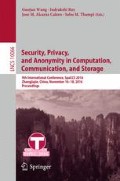Abstract
In real applications, many systems have the different security, but their securities are considered to be consistent. In other words, two workflow net systems with different security policies, are thought to be completely similar (i.e., their similarity degree is 1) by the formula proposed by Mendling et al. However, we find that their definition is not accurate. The reason is that the related definition does not accurately feature the relations of transitions. Therefore, this paper refines the relations of transitions based on event relations in the branching processes. And then to distinguish these two systems, we define the security consistency and security consistency degree, and propose a new formula to compute the security similarity degree of two nets. Additionally, this paper utilizes some examples to show these definitions, computation as well as the advantages.
Access this chapter
Tax calculation will be finalised at checkout
Purchases are for personal use only
References
van der Aalst, W.M., van Hee, K.M., ter Hofstede, A.H., Sidorova, N., Verbeek, H., Voorhoeve, M., Wynn, M.T.: Soundness of workflow nets: classification, decidability, and analysis. J. Formal Aspects Comput. 23, 333–363 (2011)
Liu, G., Jiang, C.: Secure bisimulation for interactive systems. In: Wang, G., Zomaya, A., Perez, G.M., Li, K. (eds.) ICA3PP 2015. LNCS, vol. 9530, pp. 625–639. Springer, Heidelberg (2015). doi:10.1007/978-3-319-27137-8_45
Dijkman, R., Dumas, M., Van Dongen, B., Krik, R., Mendling, J.: Similarity of business process models: metrics and evaluation. J. Inf. Syst. 36, 498–516 (2011)
Weidlich, M., Mendling, J., Weske, M.: Efficient consistency measurement based on behavioral profiles of process models. J. IEEE Trans. Softw. Eng. 37, 410–429 (2011)
Weidlich, M.: Behavioural profiles: a relational approach to behaviour consistency. Ph.D. dissertation, Universitat Potsdam, Potsdam (2011)
Dumas, M., Garca-Bauelos, L., Dijkman, R.M.: Similarity search of business process models. J. IEEE Data Eng. Bull. 32, 23–28 (2009)
Rull, G., Farr, C., Teniente, E., Urp Tubella, A.: Validation of mappings between schemas. J. Data Knowl. Eng. 63, 414–437 (2008)
Glabbeek, R.J.: The linear time - branching time spectrum. In: Baeten, J.C.M., Klop, J.W. (eds.) CONCUR 1990. LNCS, vol. 458, pp. 278–297. Springer, Heidelberg (1990). doi:10.1007/BFb0039066
Cheval, V., Cortier, V., Delaune, S.: Deciding equivalence-based properties using constraint solving. J. Theor. Comput. Sci. 492, 1–39 (2013)
Buchholz, P., Kriege, J., Scheftelowitsch, D.: Equivalence and minimization for model checking labeled Markov chains. In: 9th EAI International Conference on Performance Evaluation Methodologies and Tools, pp. 119–126. ICST (2016)
Ciancarini, P., Gorrieri, R., Zavattaro, G.: Towards a calculus for generative. J. Formal Methods Open Object Based Distrib. Syst. 1, 283 (2016)
Fioriti, L.M.F., Hashemi, V., Hermanns, H., Turrini, A.: Deciding probabilistic automata weak bisimulation: theory and practice. Formal Aspects Comput. 28, 109–143 (2016)
Sangiorgi, D., Vignudelli, V.: Environmental bisimulations for probabilistic higher-order languages. In: 43rd Annual ACM SIGPLAN-SIGACT Symposium on Principles of Programming Languages, pp. 595–607. ACM (2016)
Luttik, B.: Unique parallel decomposition in branching and weak bisimulation semantics. J. Theor. Comput. Sci. 612, 29–44 (2016)
Polyvyanyy, A., Armas-Cervantes, A., Dumas, M., Garca-Banuelos, L.: On the expressive power of behavioral profiles. J. Formal Aspects Comput. 1, 1–17 (2016)
Weidlich, M., Weske, M., Mendling, J.: Change propagation in process models using behavioural profiles. In: IEEE International Conference on Services Computing, pp. 33–40. IEEE (2009)
Weidlich, M., Polyvyanyy, A., Desai, N., Mendling, J., Weske, M.: Process compliance analysis based on behavioural profiles. J. Inf. Syst. 36, 1009–1025 (2011)
Smirnov, S., Weidlich, M., Mendling, J.: Business process model abstraction based on synthesis from well-structured behavioral profiles. Int. J. Coop. Inf. Syst. 21, 55–83 (2012)
Weidlich, M., Dijkman, R., Weske, M.: Behaviour equivalence and compatibility of business process models with complex correspondences. Comput. J. 55, 1398–1418 (2012)
Murata, T.: Petri nets: properties, analysis and applications. Proc. IEEE 77, 541–580 (1989)
Peterson, J.L.: Petri nets. J. ACM Comput. Surv. (CSUR) 9, 223–252 (1977)
Wang, S., Gan, M., Zhou, M., You, D.: A reduced reachability tree for a class of unbounded Petri nets. IEEE/CAA J. Automatica Sin. 2, 345–352 (2015)
Van Der Aalst, W.M.: WOFLAN: a Petri-net-based workflow analyzer. Syst. Anal. Model. Simul. 35, 345–358 (1999)
Van der Aalst, W.M.: The application of Petri nets to workflow management. J. Circ. Syst. Comput. 8, 21–66 (1998)
Aalst, W.M.P.: Verification of workflow nets. In: Azéma, P., Balbo, G. (eds.) ICATPN 1997. LNCS, vol. 1248, pp. 407–426. Springer, Heidelberg (1997). doi:10.1007/3-540-63139-9_48
Couvreur, J.-M., Poitrenaud, D., Weil, P.: Branching processes of general Petri nets. In: Kristensen, L.M., Petrucci, L. (eds.) PETRI NETS 2011. LNCS, vol. 6709, pp. 129–148. Springer, Heidelberg (2011). doi:10.1007/978-3-642-21834-7_8
Engelfriet, J.: Branching processes of Petri nets. J. Acta Informatica 28, 575–591 (1991)
Acknowledgments
This paper is partially supported by the National Natural Science Foundation of China under grant Nos. 91218301 and 61572360.
Author information
Authors and Affiliations
Corresponding author
Editor information
Editors and Affiliations
Rights and permissions
Copyright information
© 2016 Springer International Publishing AG
About this paper
Cite this paper
Wang, M., Liu, G., Jiang, C., Yan, C. (2016). Computation of Secure Consistency for Real Systems. In: Wang, G., Ray, I., Alcaraz Calero, J., Thampi, S. (eds) Security, Privacy, and Anonymity in Computation, Communication, and Storage. SpaCCS 2016. Lecture Notes in Computer Science(), vol 10066. Springer, Cham. https://doi.org/10.1007/978-3-319-49148-6_8
Download citation
DOI: https://doi.org/10.1007/978-3-319-49148-6_8
Published:
Publisher Name: Springer, Cham
Print ISBN: 978-3-319-49147-9
Online ISBN: 978-3-319-49148-6
eBook Packages: Computer ScienceComputer Science (R0)

